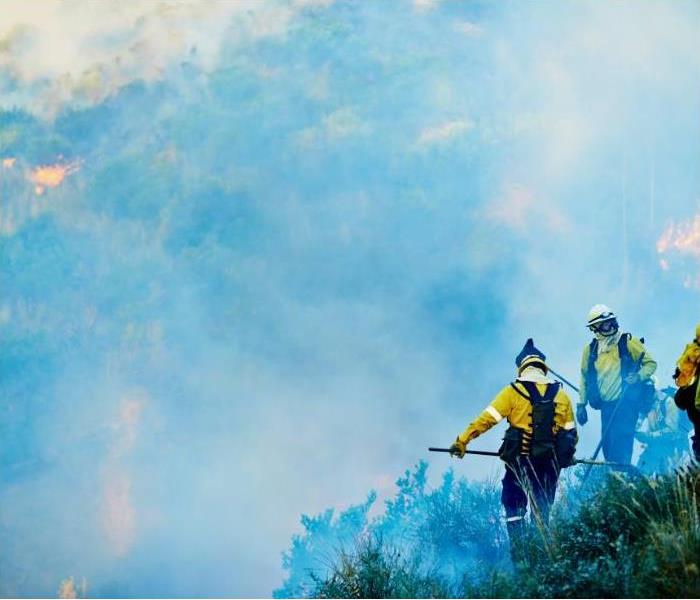Protecting Your Home and Community: Fire Risks in Salt Lake City, Utah, and How to Mitigate Them
7/5/2024 (Permalink)
Nestled against the backdrop of the stunning Wasatch Range, Salt Lake City, Utah, boasts natural beauty that captivates residents and visitors alike. However, this picturesque setting also comes with its share of challenges, one of the most significant being the risk of wildfires. As climate change intensifies, the threat of wildfires in Utah and across the western United States has become more prominent. This blog aims to raise awareness about fire risks in Salt Lake City and provide practical tips on how residents can protect their homes and communities.
1. Understanding Fire Risks in Salt Lake City:
Salt Lake City and its surrounding areas are not immune to the dangers of wildfires, especially during the dry summer months. Utah's diverse landscapes, ranging from lush forests to arid foothills, create an environment where fires can spread quickly and devastate communities. Human activities, such as campfires, discarded cigarettes, and even sparks from equipment, contribute to the ignition of wildfires.
2. Factors contributing to fire risks in Salt Lake City:
Climate Conditions:
The semi-arid climate in Salt Lake City means that the region experiences hot and dry conditions, especially in the summer. Prolonged periods of drought increase the likelihood of vegetation becoming highly flammable, providing fuel for wildfires.
Wildland-Urban Interface:
Many residential areas in Salt Lake City are situated in close proximity to natural vegetation, creating a wildland-urban interface. This proximity increases the risk of wildfires spreading from forests or grasslands to residential areas.
Wind Patterns:
The geography of Salt Lake City, with its valleys and mountain ranges, can create wind patterns that facilitate the rapid spread of wildfires. High winds can carry embers over long distances, igniting new fires and making containment efforts challenging.
3. Mitigating Fire Risks:
Create Defensible Space:
Homeowners can take proactive steps to create defensible space around their properties. This involves removing combustible materials, such as dead vegetation, leaves, and branches, within a certain radius of the home. Additionally, maintaining a safe distance between trees and structures can help prevent the spread of fires.
Fire-Resistant Landscaping:
Choosing fire-resistant plants for landscaping can be a crucial step in reducing the risk of wildfires. Opt for plants with high moisture content and low flammability, and maintain a defensible space by regularly pruning vegetation.
Building with Fire-Resistant Materials:
When constructing or renovating homes, using fire-resistant materials can provide an added layer of protection. Materials such as Class A fire-rated roofing, tempered glass windows, and non-combustible siding can help prevent the spread of flames.
Clearing Gutters and Roofs:
Regularly clearing gutters and roofs of debris, such as leaves and pine needles, can prevent the accumulation of flammable materials. Embers from a nearby wildfire can easily ignite accumulated debris on roofs, posing a significant threat to homes.
Embrace Fire-Smart Practices:
Educating the community about fire-smart practices is essential. This includes promoting responsible campfire use, discouraging the use of fireworks in high-risk areas, and ensuring proper disposal of cigarette butts.
4. Community Engagement and Preparedness:
Emergency Preparedness Plans:
Communities in Salt Lake City should develop and implement emergency preparedness plans. This includes establishing evacuation routes, organizing community drills, and ensuring that residents are aware of emergency procedures.
Community Cleanup Events:
Regular community cleanup events can help reduce the risk of wildfires by clearing common areas of combustible materials. This collaborative effort fosters a sense of shared responsibility and strengthens community resilience.
Reporting Suspicious Activities:
Encouraging residents to report suspicious activities, such as illegal burning or reckless behavior, can help authorities address potential fire hazards before they escalate.
Firebreaks and Controlled Burns:
Authorities can create firebreaks – cleared areas that act as barriers to slow or stop the progress of a wildfire. Additionally, controlled burns, when safely executed, can reduce excess vegetation and mitigate the risk of uncontrolled wildfires.
In conclusion, as residents of Salt Lake City, Utah, bask in the beauty of their surroundings, it's crucial to remain vigilant against the ever-present threat of wildfires. By understanding the factors that contribute to fire risks and taking proactive measures to mitigate them, individuals and communities can play a pivotal role in safeguarding their homes and the natural landscapes they cherish. Through a combination of responsible land management, fire-resistant building practices, and community engagement, Salt Lake City can enhance its resilience in the face of wildfire challenges, ensuring the safety and well-being of its residents for generations to come.

 24/7 Emergency Service
24/7 Emergency Service
